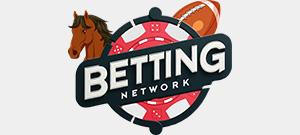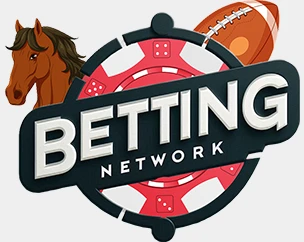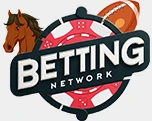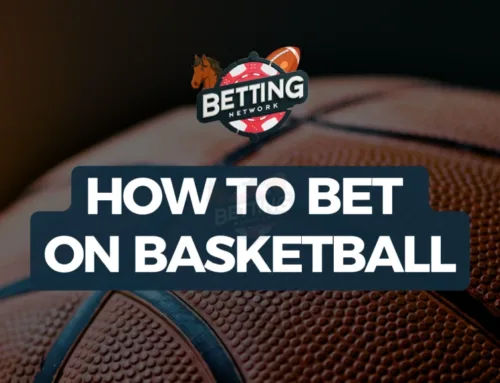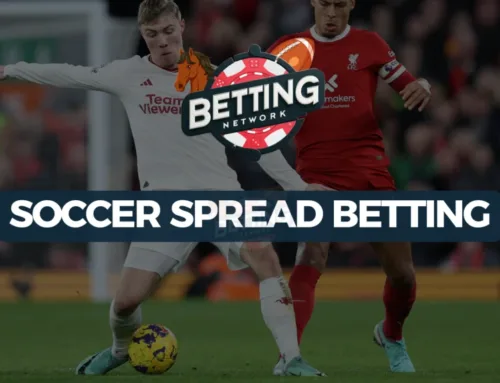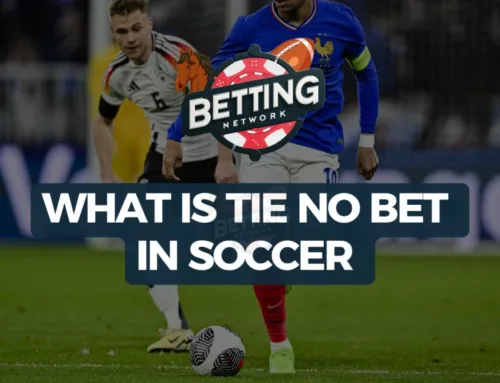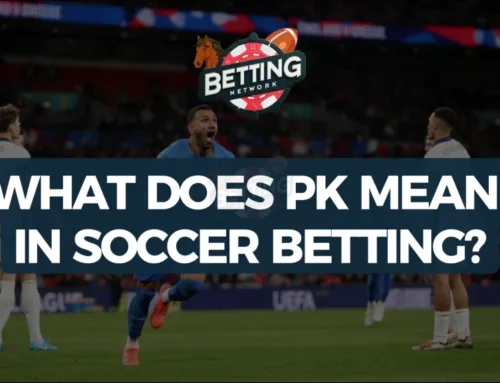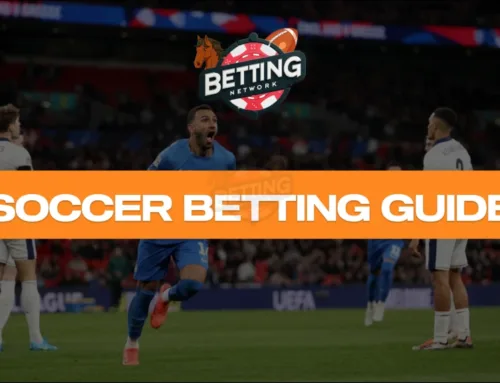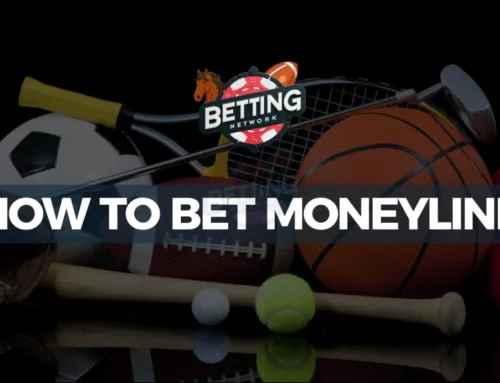NBA Betting Strategy is becoming a bit of a mainstream topic now, thanks to the sport’s growing popularity around the globe. The games are high-paced and thrilling, but there’s nothing like having some money and serious stakes riding on a game to make things even more interesting.
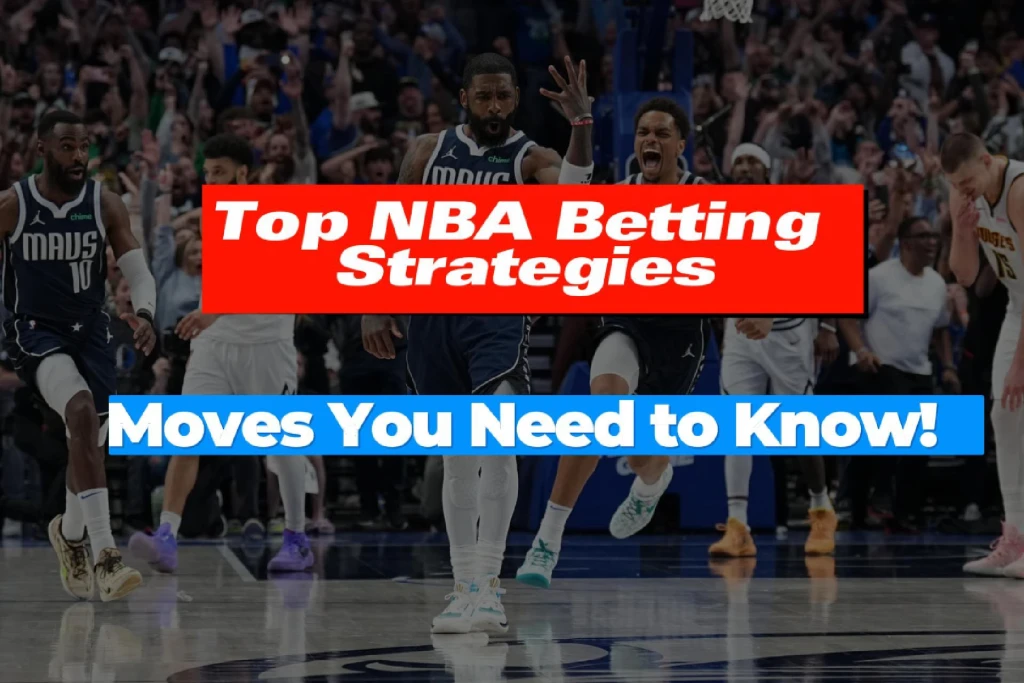
Today, I’ll show you my favorite NBA betting strategy, which bets to avoid and all the knowledge I wish I had when I started years ago. Let’s begin!
NBA Strategy Basics: Types of Bets
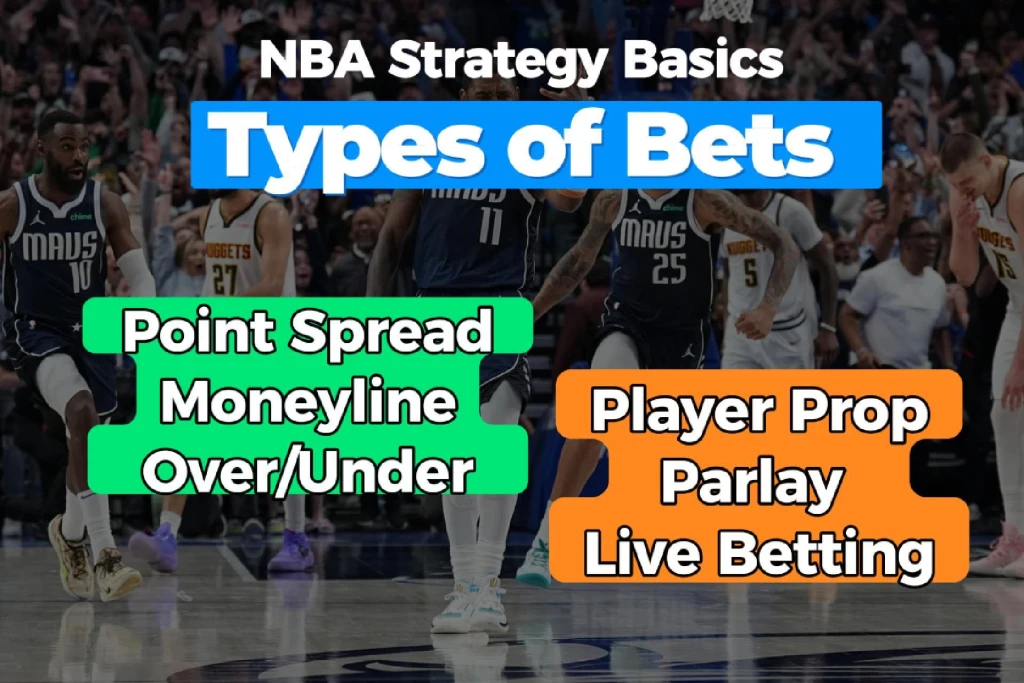
Before I show you my favorite strategy, I’ll quickly go over the fundamentals to make sure we’re all on the same page. If you’re new to this, I highly recommend you take a look at our How to Bet on Basketball guide since it explains all the concepts in tremendous detail. Think of this as a bit of crash course.
Point Spread NBA Betting
This is the most popular type of NBA bet due to its juicy payouts. These bets apply a handicap to the favorite team to even the playing field. You want to assess quality difference between both teams, recent form, key injuries and home-court advantage for these bets. We teach you how to make more money with these bets on our NBA Spread Betting guide.
Moneyline NBA Betting
You bet on which team will win the game, there’s no point spread or handicap to account for here. You save these for games where you’re confident a team will take the win, or when an underdog has a serious chance of taking the win. Favorites with a crappy traveling schedule are prone to losing to underdogs (more on this later), so there’s big payouts opportunities here.
Over/Under (Totals) NBA Betting
You try to predict whether the total points scored in a game will be over or under a specified number. The bookmaker specifies these numbers as well as the odds, so you’ll especially want to do some line shopping for these bets. We’ll talk more about line shopping later, don’t worry.
Parlay NBA Betting
Parlays roll two or more bets into one combo bet. Each bet is called a leg, and you have to correctly predict all the legs if you want to win. We talk more about how to make money with these bets on our NBA Parlay Bet guide, so check that out once you’re done here.
Player Prop Betting
These bets focus on individual player performance, so you could bet on how many points or rebounds a player will get during the game. These are a bit more advanced, since you have to analyze matchups, individual player performance trends throughout the season and specific teams, etc. Definitely a better pick for NBA betting veterans.
NBA Live Betting
You basically bet during the game as it plays out, you’ll see the odds constantly shift based on the game’s natural ebb and flow. I’d recommend these bets for the veteran NBA gamblers and big fans of the game that know how to spot momentum shifts and capitalize on them.
Developing this almost sixth-sense for things requires a lot of practice and above-average observational skills, and it’s the only reason why I wouldn’t recommend them to a newbie. Otherwise, they’re incredibly fun especially if you’re betting with the boys.
What Every Good NBA Betting Strategy Tracks
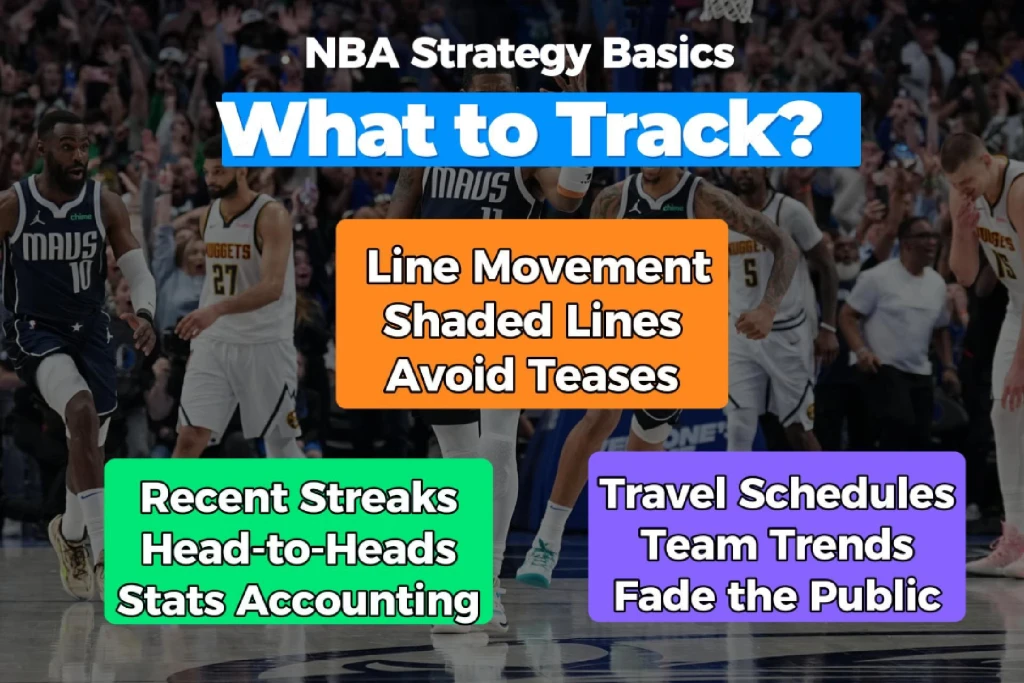
I’ve already crafted my own NBA betting strategy, and I’ll share it with you today. However, you should know the hallmarks of a good NBA betting strategy, and all the factors I’ve incorporated into mine.
You’re free to take what I’ll recommend and make something even better, or just use all of these tips to create a winning NBA betting strategy that’ll make you rich, that’s up to you.
Anyways, here’s how I turn a crappy strategy into a good one:
Follow the Line Movement
Look, I’ve seen a line move from -5.5 to -7.5, and it’s because a lot of people bet on the team to beat a depleted opponent that was missing two of its three best players, and was starting a rookie center who had less than 100 minutes of competitive basketball since high school.
I knew why the line moved because I did my homework. Any NBA betting strategy that makes money will recommend you to do the same before you interpret line movements.
When a line moves it’s because either something about the game or lineups changed (could be an injury, suspension or the coach beefing with a star and benching him). Could also be because the bookmakers have too much liability in one direction and are trying to even it out. You create artificial value on an outcome that probably won’t happen to get people to take “good” odds.
Which takes me to my next NBA Betting Strategy tip.
Learn to Spot Shaded Lines
A shaded line in betting is when the sportsbook balances the odds when they expect most of the action to go one way. They balance the books and reduce risks if, for example, they know a lot of local fans will bet on the home team, they’ll shade the line to make the home team less favorable—meaning you’ll get slightly worse odds if you bet on them.
It’s that artificial value I was just talking about. They don’t actually think the home team will lose; they just make the odds way better for the other team to get you to put money on the underdog. I’m all for taking good odds if the information supports they’re a good pick, but I’m not taking the bookies words for it.
Avoid Tease Bets
Yeah, yeah, I know this one’s going to be controversial but trust me, I’m doing you a favor. A teaser lets you adjust the point spread or totals in your favor, but in exchange, the payout is lower. It sounds tempting because you get a more “comfortable” spread, but the fact is that NBA games don’t have key numbers like football and it’s too momentum-based.
The points swing too wildly so that extra cushion rarely makes a difference, to the point I’d rather take a parlay I’m very confident in, or even straight bets if you’re a beginner to working spreads.
Reading the Travel Schedule
Understanding how the travel schedule affects a team’s performance is huge. Not even the best team can run back-to-back, 3 games in 4 nights and this is something that happens more often than you think during the season. A good team under this level of fatigue will sprint in the first quarter and then tire out real quick. Imagine if, on top of everything, they have to travel too and you’ll understand why some underdogs can pull some major upsets, which means bigger payouts for us.
Learn to Fade the Public
I’m not gonna sugarcoat it: if I don’t think a team has it in them to win or cover a spread, I’m betting against them. I know this tip might seem a bit counterintuitive after the last one, but hear me out cause there’s nuance.
In betting, “fade” means betting against a particular team or player. It’s like saying, “I don’t trust them to win or cover the spread.” It’s not about being a contrarian cause that’d mean you’re betting with your emotions, it’s more about spotting overhyped teams or lines that seem off. If you notice that public money is overwhelmingly on one side, it might be smart to “fade the public” because oddsmakers often adjust lines to take advantage of this bias.
But how do you know if that’s the right move? Easy, look at trends, injury reports, recent performances, history between two teams, key scorer performance against a team, etc. The numbers will let you see what’s going on and make you a winner when you fade the public.
Reading Team Performance and Trends
Any decent NBA Betting strategy needs to get real data to uncover good odds and bets in the sea of trash that is usually offered by sportsbooks. I’ll cover all the stuff I considered for the NBA strategy that I’ll share with you at the end.
Home and Away Performance
It’s no secret that some teams draw from the crowd’s energy and support more than others, while other teams are just more accustomed to their own court. You’ll definitely want to factor this in for potential upsets against otherwise favorites in a matchup. The most interesting part is for Away games, since they can lead to fatigue on certain conditions which we already talked about on our tip about reading travel schedules.
Recent Performance and Streaks
This one is a no-brainer: you want to see if a team is on a hot streak, or if you’re going through a performance valley ahead of a match, but there’s so much more to be analyzed. For example, some teams go flat after strong starts, and other seem to get an unnatural second wind to their play later in the season, right?
It’s something that happens almost every season, but have you noticed that some coaches are known to specifically have strong starts and terrible finishes to their seasons too? Once you start considering additional pieces of data that support your performance projections, you’ll start making some serious bets. That leads me to the next factor too.
Head-to-Head Matchups
Some matches are just special: they have a lot of history and beef going for them, but there’s also data to be noticed. Sometimes, there’s a very clear dominance from one side, sometimes a favorite will have a bit of an Achilles heel for an opponent, etc.
When you start factoring this key piece of data into an analysis that goes over all the stuff we’ve talked about, you start cooking some big-money predictions.
Injuries and Performance
This is another key piece of data that most people think they got down, right until they place a fat bet without having a lineup confirmed. We all know that key players that get injured at the last moment will move the line in a big way, but many casual bettors don’t even keep up with injury reports before placing a bet with their heart. Don’t be like that.
Performance Statistics
Look, I’ll be honest: I like looking at historical data and the shape of teams right before they face their rivals, but I’m not that big on player statistics. I only look at them to confirm whether or not a player I consider fundamental to the team’s performance, is indeed a key player. We all have our favorites and it’s important to look at the stats to see if a player is performing at max level or not, we can’t be biased about it.
Some players act as the perfect counter against specific teams too, and it could end up having a big impact on the final score, assuming that he’s not injured or benched. Some of the stuff I like to quickly look at are:
- Player Efficiency Rating (PER)
- Expected Points per 100 Possessions
- Turnover Ratios and Rebound Percentages
- Effective Field Goal Percentage (eFG%)
Again, don’t go too overboard on this. The other factors have given me better prediction outcomes, but these are nice to know. If you want a deeper look at what these stats mean, check out our How to Bet on Basketball guide.
Now let me share my favorite NBA Betting Strategy.
FAQs About NBA Betting Strategy
How does the point spread work in NBA betting?
The point spread is used to level the playing field between the favorite and the underdog by adding or subtracting points to the final score.
What is the best NBA betting strategy?
There is no one-size-fits-all strategy, but knowing why the line moves, reading team’s traveling schedules and tracking recent performances are all key parts of a good strategy.
How do you analyze NBA games for betting?
Consider team and player statistics, recent form, home and away records, injury reports, and head-to-head matchups and the team’s traveling schedule.
Is NBA live betting profitable?
Live betting can be profitable if you can quickly read the game’s ebb and flow, key momentum shifts and assertively make decisions on the fly.
NBA Betting Strategy is becoming a bit of a mainstream topic now, thanks to the sport’s growing popularity around the globe. The games are high-paced and thrilling, but there’s nothing like having some money and serious stakes riding on a game to make things even more interesting.

Today, I’ll show you my favorite NBA betting strategy, which bets to avoid and all the knowledge I wish I had when I started years ago. Let’s begin!
NBA Strategy Basics: Types of Bets

Before I show you my favorite strategy, I’ll quickly go over the fundamentals to make sure we’re all on the same page. If you’re new to this, I highly recommend you take a look at our How to Bet on Basketball guide since it explains all the concepts in tremendous detail. Think of this as a bit of crash course.
Point Spread NBA Betting
This is the most popular type of NBA bet due to its juicy payouts. These bets apply a handicap to the favorite team to even the playing field. You want to assess quality difference between both teams, recent form, key injuries and home-court advantage for these bets. We teach you how to make more money with these bets on our NBA Spread Betting guide.
Moneyline NBA Betting
You bet on which team will win the game, there’s no point spread or handicap to account for here. You save these for games where you’re confident a team will take the win, or when an underdog has a serious chance of taking the win. Favorites with a crappy traveling schedule are prone to losing to underdogs (more on this later), so there’s big payouts opportunities here.
Over/Under (Totals) NBA Betting
You try to predict whether the total points scored in a game will be over or under a specified number. The bookmaker specifies these numbers as well as the odds, so you’ll especially want to do some line shopping for these bets. We’ll talk more about line shopping later, don’t worry.
Parlay NBA Betting
Parlays roll two or more bets into one combo bet. Each bet is called a leg, and you have to correctly predict all the legs if you want to win. We talk more about how to make money with these bets on our NBA Parlay Bet guide, so check that out once you’re done here.
Player Prop Betting
These bets focus on individual player performance, so you could bet on how many points or rebounds a player will get during the game. These are a bit more advanced, since you have to analyze matchups, individual player performance trends throughout the season and specific teams, etc. Definitely a better pick for NBA betting veterans.
NBA Live Betting
You basically bet during the game as it plays out, you’ll see the odds constantly shift based on the game’s natural ebb and flow. I’d recommend these bets for the veteran NBA gamblers and big fans of the game that know how to spot momentum shifts and capitalize on them.
Developing this almost sixth-sense for things requires a lot of practice and above-average observational skills, and it’s the only reason why I wouldn’t recommend them to a newbie. Otherwise, they’re incredibly fun especially if you’re betting with the boys.
What Every Good NBA Betting Strategy Tracks

I’ve already crafted my own NBA betting strategy, and I’ll share it with you today. However, you should know the hallmarks of a good NBA betting strategy, and all the factors I’ve incorporated into mine.
You’re free to take what I’ll recommend and make something even better, or just use all of these tips to create a winning NBA betting strategy that’ll make you rich, that’s up to you.
Anyways, here’s how I turn a crappy strategy into a good one:
Follow the Line Movement
Look, I’ve seen a line move from -5.5 to -7.5, and it’s because a lot of people bet on the team to beat a depleted opponent that was missing two of its three best players, and was starting a rookie center who had less than 100 minutes of competitive basketball since high school.
I knew why the line moved because I did my homework. Any NBA betting strategy that makes money will recommend you to do the same before you interpret line movements.
When a line moves it’s because either something about the game or lineups changed (could be an injury, suspension or the coach beefing with a star and benching him). Could also be because the bookmakers have too much liability in one direction and are trying to even it out. You create artificial value on an outcome that probably won’t happen to get people to take “good” odds.
Which takes me to my next NBA Betting Strategy tip.
Learn to Spot Shaded Lines
A shaded line in betting is when the sportsbook balances the odds when they expect most of the action to go one way. They balance the books and reduce risks if, for example, they know a lot of local fans will bet on the home team, they’ll shade the line to make the home team less favorable—meaning you’ll get slightly worse odds if you bet on them.
It’s that artificial value I was just talking about. They don’t actually think the home team will lose; they just make the odds way better for the other team to get you to put money on the underdog. I’m all for taking good odds if the information supports they’re a good pick, but I’m not taking the bookies words for it.
Avoid Tease Bets
Yeah, yeah, I know this one’s going to be controversial but trust me, I’m doing you a favor. A teaser lets you adjust the point spread or totals in your favor, but in exchange, the payout is lower. It sounds tempting because you get a more “comfortable” spread, but the fact is that NBA games don’t have key numbers like football and it’s too momentum-based.
The points swing too wildly so that extra cushion rarely makes a difference, to the point I’d rather take a parlay I’m very confident in, or even straight bets if you’re a beginner to working spreads.
Reading the Travel Schedule
Understanding how the travel schedule affects a team’s performance is huge. Not even the best team can run back-to-back, 3 games in 4 nights and this is something that happens more often than you think during the season. A good team under this level of fatigue will sprint in the first quarter and then tire out real quick. Imagine if, on top of everything, they have to travel too and you’ll understand why some underdogs can pull some major upsets, which means bigger payouts for us.
Learn to Fade the Public
I’m not gonna sugarcoat it: if I don’t think a team has it in them to win or cover a spread, I’m betting against them. I know this tip might seem a bit counterintuitive after the last one, but hear me out cause there’s nuance.
In betting, “fade” means betting against a particular team or player. It’s like saying, “I don’t trust them to win or cover the spread.” It’s not about being a contrarian cause that’d mean you’re betting with your emotions, it’s more about spotting overhyped teams or lines that seem off. If you notice that public money is overwhelmingly on one side, it might be smart to “fade the public” because oddsmakers often adjust lines to take advantage of this bias.
But how do you know if that’s the right move? Easy, look at trends, injury reports, recent performances, history between two teams, key scorer performance against a team, etc. The numbers will let you see what’s going on and make you a winner when you fade the public.
Reading Team Performance and Trends
Any decent NBA Betting strategy needs to get real data to uncover good odds and bets in the sea of trash that is usually offered by sportsbooks. I’ll cover all the stuff I considered for the NBA strategy that I’ll share with you at the end.
Home and Away Performance
It’s no secret that some teams draw from the crowd’s energy and support more than others, while other teams are just more accustomed to their own court. You’ll definitely want to factor this in for potential upsets against otherwise favorites in a matchup. The most interesting part is for Away games, since they can lead to fatigue on certain conditions which we already talked about on our tip about reading travel schedules.
Recent Performance and Streaks
This one is a no-brainer: you want to see if a team is on a hot streak, or if you’re going through a performance valley ahead of a match, but there’s so much more to be analyzed. For example, some teams go flat after strong starts, and other seem to get an unnatural second wind to their play later in the season, right?
It’s something that happens almost every season, but have you noticed that some coaches are known to specifically have strong starts and terrible finishes to their seasons too? Once you start considering additional pieces of data that support your performance projections, you’ll start making some serious bets. That leads me to the next factor too.
Head-to-Head Matchups
Some matches are just special: they have a lot of history and beef going for them, but there’s also data to be noticed. Sometimes, there’s a very clear dominance from one side, sometimes a favorite will have a bit of an Achilles heel for an opponent, etc.
When you start factoring this key piece of data into an analysis that goes over all the stuff we’ve talked about, you start cooking some big-money predictions.
Injuries and Performance
This is another key piece of data that most people think they got down, right until they place a fat bet without having a lineup confirmed. We all know that key players that get injured at the last moment will move the line in a big way, but many casual bettors don’t even keep up with injury reports before placing a bet with their heart. Don’t be like that.
Performance Statistics
Look, I’ll be honest: I like looking at historical data and the shape of teams right before they face their rivals, but I’m not that big on player statistics. I only look at them to confirm whether or not a player I consider fundamental to the team’s performance, is indeed a key player. We all have our favorites and it’s important to look at the stats to see if a player is performing at max level or not, we can’t be biased about it.
Some players act as the perfect counter against specific teams too, and it could end up having a big impact on the final score, assuming that he’s not injured or benched. Some of the stuff I like to quickly look at are:
- Player Efficiency Rating (PER)
- Expected Points per 100 Possessions
- Turnover Ratios and Rebound Percentages
- Effective Field Goal Percentage (eFG%)
Again, don’t go too overboard on this. The other factors have given me better prediction outcomes, but these are nice to know. If you want a deeper look at what these stats mean, check out our How to Bet on Basketball guide.
Now let me share my favorite NBA Betting Strategy.
FAQs About NBA Betting Strategy
How does the point spread work in NBA betting?
The point spread is used to level the playing field between the favorite and the underdog by adding or subtracting points to the final score.
What is the best NBA betting strategy?
There is no one-size-fits-all strategy, but knowing why the line moves, reading team’s traveling schedules and tracking recent performances are all key parts of a good strategy.
How do you analyze NBA games for betting?
Consider team and player statistics, recent form, home and away records, injury reports, and head-to-head matchups and the team’s traveling schedule.
Is NBA live betting profitable?
Live betting can be profitable if you can quickly read the game’s ebb and flow, key momentum shifts and assertively make decisions on the fly.
NBA Betting Strategy is becoming a bit of a mainstream topic now, thanks to the sport’s growing popularity around the globe. The games are high-paced and thrilling, but there’s nothing like having some money and serious stakes riding on a game to make things even more interesting.

Today, I’ll show you my favorite NBA betting strategy, which bets to avoid and all the knowledge I wish I had when I started years ago. Let’s begin!
NBA Strategy Basics: Types of Bets

Before I show you my favorite strategy, I’ll quickly go over the fundamentals to make sure we’re all on the same page. If you’re new to this, I highly recommend you take a look at our How to Bet on Basketball guide since it explains all the concepts in tremendous detail. Think of this as a bit of crash course.
Point Spread NBA Betting
This is the most popular type of NBA bet due to its juicy payouts. These bets apply a handicap to the favorite team to even the playing field. You want to assess quality difference between both teams, recent form, key injuries and home-court advantage for these bets. We teach you how to make more money with these bets on our NBA Spread Betting guide.
Moneyline NBA Betting
You bet on which team will win the game, there’s no point spread or handicap to account for here. You save these for games where you’re confident a team will take the win, or when an underdog has a serious chance of taking the win. Favorites with a crappy traveling schedule are prone to losing to underdogs (more on this later), so there’s big payouts opportunities here.
Over/Under (Totals) NBA Betting
You try to predict whether the total points scored in a game will be over or under a specified number. The bookmaker specifies these numbers as well as the odds, so you’ll especially want to do some line shopping for these bets. We’ll talk more about line shopping later, don’t worry.
Parlay NBA Betting
Parlays roll two or more bets into one combo bet. Each bet is called a leg, and you have to correctly predict all the legs if you want to win. We talk more about how to make money with these bets on our NBA Parlay Bet guide, so check that out once you’re done here.
Player Prop Betting
These bets focus on individual player performance, so you could bet on how many points or rebounds a player will get during the game. These are a bit more advanced, since you have to analyze matchups, individual player performance trends throughout the season and specific teams, etc. Definitely a better pick for NBA betting veterans.
NBA Live Betting
You basically bet during the game as it plays out, you’ll see the odds constantly shift based on the game’s natural ebb and flow. I’d recommend these bets for the veteran NBA gamblers and big fans of the game that know how to spot momentum shifts and capitalize on them.
Developing this almost sixth-sense for things requires a lot of practice and above-average observational skills, and it’s the only reason why I wouldn’t recommend them to a newbie. Otherwise, they’re incredibly fun especially if you’re betting with the boys.
What Every Good NBA Betting Strategy Tracks

I’ve already crafted my own NBA betting strategy, and I’ll share it with you today. However, you should know the hallmarks of a good NBA betting strategy, and all the factors I’ve incorporated into mine.
You’re free to take what I’ll recommend and make something even better, or just use all of these tips to create a winning NBA betting strategy that’ll make you rich, that’s up to you.
Anyways, here’s how I turn a crappy strategy into a good one:
Follow the Line Movement
Look, I’ve seen a line move from -5.5 to -7.5, and it’s because a lot of people bet on the team to beat a depleted opponent that was missing two of its three best players, and was starting a rookie center who had less than 100 minutes of competitive basketball since high school.
I knew why the line moved because I did my homework. Any NBA betting strategy that makes money will recommend you to do the same before you interpret line movements.
When a line moves it’s because either something about the game or lineups changed (could be an injury, suspension or the coach beefing with a star and benching him). Could also be because the bookmakers have too much liability in one direction and are trying to even it out. You create artificial value on an outcome that probably won’t happen to get people to take “good” odds.
Which takes me to my next NBA Betting Strategy tip.
Learn to Spot Shaded Lines
A shaded line in betting is when the sportsbook balances the odds when they expect most of the action to go one way. They balance the books and reduce risks if, for example, they know a lot of local fans will bet on the home team, they’ll shade the line to make the home team less favorable—meaning you’ll get slightly worse odds if you bet on them.
It’s that artificial value I was just talking about. They don’t actually think the home team will lose; they just make the odds way better for the other team to get you to put money on the underdog. I’m all for taking good odds if the information supports they’re a good pick, but I’m not taking the bookies words for it.
Avoid Tease Bets
Yeah, yeah, I know this one’s going to be controversial but trust me, I’m doing you a favor. A teaser lets you adjust the point spread or totals in your favor, but in exchange, the payout is lower. It sounds tempting because you get a more “comfortable” spread, but the fact is that NBA games don’t have key numbers like football and it’s too momentum-based.
The points swing too wildly so that extra cushion rarely makes a difference, to the point I’d rather take a parlay I’m very confident in, or even straight bets if you’re a beginner to working spreads.
Reading the Travel Schedule
Understanding how the travel schedule affects a team’s performance is huge. Not even the best team can run back-to-back, 3 games in 4 nights and this is something that happens more often than you think during the season. A good team under this level of fatigue will sprint in the first quarter and then tire out real quick. Imagine if, on top of everything, they have to travel too and you’ll understand why some underdogs can pull some major upsets, which means bigger payouts for us.
Learn to Fade the Public
I’m not gonna sugarcoat it: if I don’t think a team has it in them to win or cover a spread, I’m betting against them. I know this tip might seem a bit counterintuitive after the last one, but hear me out cause there’s nuance.
In betting, “fade” means betting against a particular team or player. It’s like saying, “I don’t trust them to win or cover the spread.” It’s not about being a contrarian cause that’d mean you’re betting with your emotions, it’s more about spotting overhyped teams or lines that seem off. If you notice that public money is overwhelmingly on one side, it might be smart to “fade the public” because oddsmakers often adjust lines to take advantage of this bias.
But how do you know if that’s the right move? Easy, look at trends, injury reports, recent performances, history between two teams, key scorer performance against a team, etc. The numbers will let you see what’s going on and make you a winner when you fade the public.
Reading Team Performance and Trends
Any decent NBA Betting strategy needs to get real data to uncover good odds and bets in the sea of trash that is usually offered by sportsbooks. I’ll cover all the stuff I considered for the NBA strategy that I’ll share with you at the end.
Home and Away Performance
It’s no secret that some teams draw from the crowd’s energy and support more than others, while other teams are just more accustomed to their own court. You’ll definitely want to factor this in for potential upsets against otherwise favorites in a matchup. The most interesting part is for Away games, since they can lead to fatigue on certain conditions which we already talked about on our tip about reading travel schedules.
Recent Performance and Streaks
This one is a no-brainer: you want to see if a team is on a hot streak, or if you’re going through a performance valley ahead of a match, but there’s so much more to be analyzed. For example, some teams go flat after strong starts, and other seem to get an unnatural second wind to their play later in the season, right?
It’s something that happens almost every season, but have you noticed that some coaches are known to specifically have strong starts and terrible finishes to their seasons too? Once you start considering additional pieces of data that support your performance projections, you’ll start making some serious bets. That leads me to the next factor too.
Head-to-Head Matchups
Some matches are just special: they have a lot of history and beef going for them, but there’s also data to be noticed. Sometimes, there’s a very clear dominance from one side, sometimes a favorite will have a bit of an Achilles heel for an opponent, etc.
When you start factoring this key piece of data into an analysis that goes over all the stuff we’ve talked about, you start cooking some big-money predictions.
Injuries and Performance
This is another key piece of data that most people think they got down, right until they place a fat bet without having a lineup confirmed. We all know that key players that get injured at the last moment will move the line in a big way, but many casual bettors don’t even keep up with injury reports before placing a bet with their heart. Don’t be like that.
Performance Statistics
Look, I’ll be honest: I like looking at historical data and the shape of teams right before they face their rivals, but I’m not that big on player statistics. I only look at them to confirm whether or not a player I consider fundamental to the team’s performance, is indeed a key player. We all have our favorites and it’s important to look at the stats to see if a player is performing at max level or not, we can’t be biased about it.
Some players act as the perfect counter against specific teams too, and it could end up having a big impact on the final score, assuming that he’s not injured or benched. Some of the stuff I like to quickly look at are:
- Player Efficiency Rating (PER)
- Expected Points per 100 Possessions
- Turnover Ratios and Rebound Percentages
- Effective Field Goal Percentage (eFG%)
Again, don’t go too overboard on this. The other factors have given me better prediction outcomes, but these are nice to know. If you want a deeper look at what these stats mean, check out our How to Bet on Basketball guide.
Now let me share my favorite NBA Betting Strategy.
FAQs About NBA Betting Strategy
How does the point spread work in NBA betting?
The point spread is used to level the playing field between the favorite and the underdog by adding or subtracting points to the final score.
What is the best NBA betting strategy?
There is no one-size-fits-all strategy, but knowing why the line moves, reading team’s traveling schedules and tracking recent performances are all key parts of a good strategy.
How do you analyze NBA games for betting?
Consider team and player statistics, recent form, home and away records, injury reports, and head-to-head matchups and the team’s traveling schedule.
Is NBA live betting profitable?
Live betting can be profitable if you can quickly read the game’s ebb and flow, key momentum shifts and assertively make decisions on the fly.
NBA Betting Strategy is becoming a bit of a mainstream topic now, thanks to the sport’s growing popularity around the globe. The games are high-paced and thrilling, but there’s nothing like having some money and serious stakes riding on a game to make things even more interesting.

Today, I’ll show you my favorite NBA betting strategy, which bets to avoid and all the knowledge I wish I had when I started years ago. Let’s begin!
NBA Strategy Basics: Types of Bets

Before I show you my favorite strategy, I’ll quickly go over the fundamentals to make sure we’re all on the same page. If you’re new to this, I highly recommend you take a look at our How to Bet on Basketball guide since it explains all the concepts in tremendous detail. Think of this as a bit of crash course.
Point Spread NBA Betting
This is the most popular type of NBA bet due to its juicy payouts. These bets apply a handicap to the favorite team to even the playing field. You want to assess quality difference between both teams, recent form, key injuries and home-court advantage for these bets. We teach you how to make more money with these bets on our NBA Spread Betting guide.
Moneyline NBA Betting
You bet on which team will win the game, there’s no point spread or handicap to account for here. You save these for games where you’re confident a team will take the win, or when an underdog has a serious chance of taking the win. Favorites with a crappy traveling schedule are prone to losing to underdogs (more on this later), so there’s big payouts opportunities here.
Over/Under (Totals) NBA Betting
You try to predict whether the total points scored in a game will be over or under a specified number. The bookmaker specifies these numbers as well as the odds, so you’ll especially want to do some line shopping for these bets. We’ll talk more about line shopping later, don’t worry.
Parlay NBA Betting
Parlays roll two or more bets into one combo bet. Each bet is called a leg, and you have to correctly predict all the legs if you want to win. We talk more about how to make money with these bets on our NBA Parlay Bet guide, so check that out once you’re done here.
Player Prop Betting
These bets focus on individual player performance, so you could bet on how many points or rebounds a player will get during the game. These are a bit more advanced, since you have to analyze matchups, individual player performance trends throughout the season and specific teams, etc. Definitely a better pick for NBA betting veterans.
NBA Live Betting
You basically bet during the game as it plays out, you’ll see the odds constantly shift based on the game’s natural ebb and flow. I’d recommend these bets for the veteran NBA gamblers and big fans of the game that know how to spot momentum shifts and capitalize on them.
Developing this almost sixth-sense for things requires a lot of practice and above-average observational skills, and it’s the only reason why I wouldn’t recommend them to a newbie. Otherwise, they’re incredibly fun especially if you’re betting with the boys.
What Every Good NBA Betting Strategy Tracks

I’ve already crafted my own NBA betting strategy, and I’ll share it with you today. However, you should know the hallmarks of a good NBA betting strategy, and all the factors I’ve incorporated into mine.
You’re free to take what I’ll recommend and make something even better, or just use all of these tips to create a winning NBA betting strategy that’ll make you rich, that’s up to you.
Anyways, here’s how I turn a crappy strategy into a good one:
Follow the Line Movement
Look, I’ve seen a line move from -5.5 to -7.5, and it’s because a lot of people bet on the team to beat a depleted opponent that was missing two of its three best players, and was starting a rookie center who had less than 100 minutes of competitive basketball since high school.
I knew why the line moved because I did my homework. Any NBA betting strategy that makes money will recommend you to do the same before you interpret line movements.
When a line moves it’s because either something about the game or lineups changed (could be an injury, suspension or the coach beefing with a star and benching him). Could also be because the bookmakers have too much liability in one direction and are trying to even it out. You create artificial value on an outcome that probably won’t happen to get people to take “good” odds.
Which takes me to my next NBA Betting Strategy tip.
Learn to Spot Shaded Lines
A shaded line in betting is when the sportsbook balances the odds when they expect most of the action to go one way. They balance the books and reduce risks if, for example, they know a lot of local fans will bet on the home team, they’ll shade the line to make the home team less favorable—meaning you’ll get slightly worse odds if you bet on them.
It’s that artificial value I was just talking about. They don’t actually think the home team will lose; they just make the odds way better for the other team to get you to put money on the underdog. I’m all for taking good odds if the information supports they’re a good pick, but I’m not taking the bookies words for it.
Avoid Tease Bets
Yeah, yeah, I know this one’s going to be controversial but trust me, I’m doing you a favor. A teaser lets you adjust the point spread or totals in your favor, but in exchange, the payout is lower. It sounds tempting because you get a more “comfortable” spread, but the fact is that NBA games don’t have key numbers like football and it’s too momentum-based.
The points swing too wildly so that extra cushion rarely makes a difference, to the point I’d rather take a parlay I’m very confident in, or even straight bets if you’re a beginner to working spreads.
Reading the Travel Schedule
Understanding how the travel schedule affects a team’s performance is huge. Not even the best team can run back-to-back, 3 games in 4 nights and this is something that happens more often than you think during the season. A good team under this level of fatigue will sprint in the first quarter and then tire out real quick. Imagine if, on top of everything, they have to travel too and you’ll understand why some underdogs can pull some major upsets, which means bigger payouts for us.
Learn to Fade the Public
I’m not gonna sugarcoat it: if I don’t think a team has it in them to win or cover a spread, I’m betting against them. I know this tip might seem a bit counterintuitive after the last one, but hear me out cause there’s nuance.
In betting, “fade” means betting against a particular team or player. It’s like saying, “I don’t trust them to win or cover the spread.” It’s not about being a contrarian cause that’d mean you’re betting with your emotions, it’s more about spotting overhyped teams or lines that seem off. If you notice that public money is overwhelmingly on one side, it might be smart to “fade the public” because oddsmakers often adjust lines to take advantage of this bias.
But how do you know if that’s the right move? Easy, look at trends, injury reports, recent performances, history between two teams, key scorer performance against a team, etc. The numbers will let you see what’s going on and make you a winner when you fade the public.
Reading Team Performance and Trends
Any decent NBA Betting strategy needs to get real data to uncover good odds and bets in the sea of trash that is usually offered by sportsbooks. I’ll cover all the stuff I considered for the NBA strategy that I’ll share with you at the end.
Home and Away Performance
It’s no secret that some teams draw from the crowd’s energy and support more than others, while other teams are just more accustomed to their own court. You’ll definitely want to factor this in for potential upsets against otherwise favorites in a matchup. The most interesting part is for Away games, since they can lead to fatigue on certain conditions which we already talked about on our tip about reading travel schedules.
Recent Performance and Streaks
This one is a no-brainer: you want to see if a team is on a hot streak, or if you’re going through a performance valley ahead of a match, but there’s so much more to be analyzed. For example, some teams go flat after strong starts, and other seem to get an unnatural second wind to their play later in the season, right?
It’s something that happens almost every season, but have you noticed that some coaches are known to specifically have strong starts and terrible finishes to their seasons too? Once you start considering additional pieces of data that support your performance projections, you’ll start making some serious bets. That leads me to the next factor too.
Head-to-Head Matchups
Some matches are just special: they have a lot of history and beef going for them, but there’s also data to be noticed. Sometimes, there’s a very clear dominance from one side, sometimes a favorite will have a bit of an Achilles heel for an opponent, etc.
When you start factoring this key piece of data into an analysis that goes over all the stuff we’ve talked about, you start cooking some big-money predictions.
Injuries and Performance
This is another key piece of data that most people think they got down, right until they place a fat bet without having a lineup confirmed. We all know that key players that get injured at the last moment will move the line in a big way, but many casual bettors don’t even keep up with injury reports before placing a bet with their heart. Don’t be like that.
Performance Statistics
Look, I’ll be honest: I like looking at historical data and the shape of teams right before they face their rivals, but I’m not that big on player statistics. I only look at them to confirm whether or not a player I consider fundamental to the team’s performance, is indeed a key player. We all have our favorites and it’s important to look at the stats to see if a player is performing at max level or not, we can’t be biased about it.
Some players act as the perfect counter against specific teams too, and it could end up having a big impact on the final score, assuming that he’s not injured or benched. Some of the stuff I like to quickly look at are:
- Player Efficiency Rating (PER)
- Expected Points per 100 Possessions
- Turnover Ratios and Rebound Percentages
- Effective Field Goal Percentage (eFG%)
Again, don’t go too overboard on this. The other factors have given me better prediction outcomes, but these are nice to know. If you want a deeper look at what these stats mean, check out our How to Bet on Basketball guide.
Now let me share my favorite NBA Betting Strategy.
FAQs About NBA Betting Strategy
How does the point spread work in NBA betting?
The point spread is used to level the playing field between the favorite and the underdog by adding or subtracting points to the final score.
What is the best NBA betting strategy?
There is no one-size-fits-all strategy, but knowing why the line moves, reading team’s traveling schedules and tracking recent performances are all key parts of a good strategy.
How do you analyze NBA games for betting?
Consider team and player statistics, recent form, home and away records, injury reports, and head-to-head matchups and the team’s traveling schedule.
Is NBA live betting profitable?
Live betting can be profitable if you can quickly read the game’s ebb and flow, key momentum shifts and assertively make decisions on the fly.
